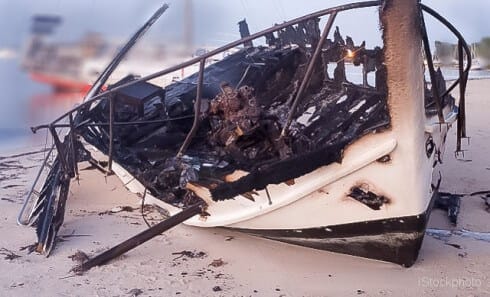
Every so often, someone sends me a link to this article, originally published in Professional Boat Builder and repeated at Sailing Anarchy, that starts with the line:
Lithium-ion batteries start fires.
First off, the author does not differentiate between lithium cobalt oxide (the battery type in your phone) and lithium iron phosphate (LiFePO), the chemistry generally used for service batteries on boats, which is much safer and less volatile.
In fact, recently, ABYC tried to set one of the latter types on fire and had no luck.
Second, he goes on to say that a large number of boat fires are caused by batteries.
I don’t think that’s true.
What I would agree to is that a large percentage of fires on boats are caused by poorly designed and installed electrical systems, and that includes those installed by the “professionals”:
The electrical system on our new-to-us J/109, as installed by the builder in 2004, was a fire looking for a place to happen, mainly because of inadequate fusing.
And then in the years after she was built and before we bought the boat and rebuilt the electrical system, “professionals” had made the fire risk far worse with stupid changes and additions.
This is a distressingly common situation, and don’t make the mistake of thinking that just because your boat has passed survey that the electrical system is safe. Ours did and wasn’t.
And don’t get me started on the dangers of electrical systems designed and installed by boat owners who watch a few YouTube videos, source lithium cells from some vendor on eBay, and have at it.
So to me, the correct statement is:
Lithium batteries don’t burn boats, poor battery and electrical installations burn boats, regardless of battery chemistry.
Me
I have written a lot more about this in this Online Book, including how to decide if lithium batteries are right for your boat:


While I completely agree with your main point, there is one major difference in that lithium batteries have some *very* impressive current delivery characteristics. This means that substandard systems that maybe you could have just got away without major incident suddenly become pretty spectacular failures when a few hundred amps are getting dumped through them (which of course shouldn’t happen with a proper BMS, which is again back to your main point…).
Like so many other things in sailing (and life) more power indiscriminately applied seldom produces desirable results.
Which, again, comes down to “poorly designed and installed electrical systems”, and not the batteries themselves.
Yeah I think we all agree that the batteries are not at fault here 🙂
I’m just trying to make a subtle point that design has to take into consideration all the parameters of the system, and that lithium batteries have some very surprising design parameters for anyone coming over from older battery chemistries. A 50+C discharge rate is a completely nuts amount of instantaneous power, but not remotely unusual in a lithium system. With those design parameters achieving a properly designed system can take a bit of work!
It’s one reason why I find the practice of selling “drop-in” lithium systems so dangerous. You can’t change one of the fundamental design parameters without then going and reviewing the design of the system as a whole. The definition of the “poorly designed” part can change when you start messing with things. I can imagine a design that I’d consider “just adequate” with a small AGM system moving to “disaster waiting to happen” when you put a couple of “drop in” lithiums behind it.
Hi Nick,
I agree on drop in batteries: https://www.morganscloud.com/2022/04/25/why-lithium-battery-load-dumps-matter/
But let’s not go off on a deep discussion of these issues on a tip that I simply intended to deal with a particular assertion, when we already have a complete online book that deals with most all the issues: https://www.morganscloud.com/category/electrical/online-book-electrical-systems/
hello,
what do you think of a mixed lifepo4 Pb assembly like the one recommended here ?
https://gilwellbear.wordpress.com/2021/04/22/lithium-chemistry-batteries-on-boats/
Hi Oliver,
I’m not at all keen on that one:
https://www.morganscloud.com/2023/01/10/a-simple-way-to-decide-between-lithium-or-lead-batteries-for-a-cruising-boat/
Don’t put lead-acid in parallel with LFP.
You can, where necessary, use a DC-to-DC charger to connect both a sensitive load, and a dedicated small AGM or gel-cell battery for that load, to the main lithium-powered bus. This is essentially the same as a “Full Conversion UPS” in computer land, and prevents any brownouts/blackouts to that specific device, at the cost of extra weight, complexity, and dollars.